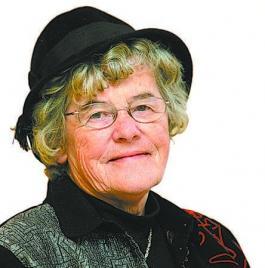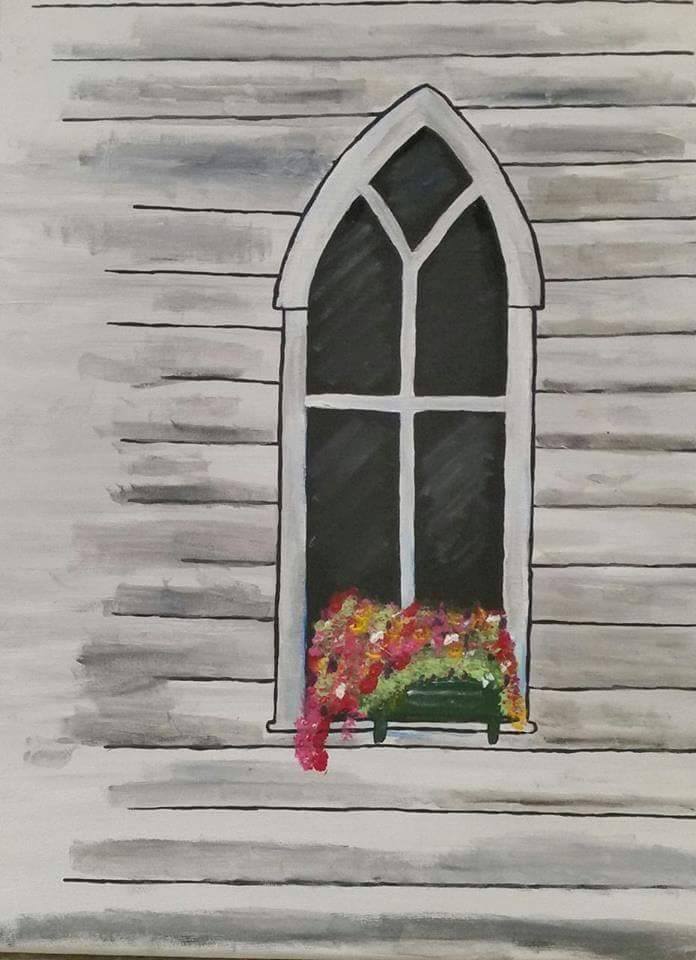
Ruby M. Cusack
Gathering Together

Nancy Cusack
Church Histories let us look into the window of the past
to get a better idea of the hand of fellowship
that was extended to many.
During the winter, when the weather became really cold and there was lots of snow, Aunt Sadie saved the heels of the loaves of bread as well as any loaves that were getting old. She threw the pieces on the beaten paths to the barns and watched as the crows cawed a message to their friends to come eat. It was amazing to see how quickly the “call” was heard and answered.
When Gramp came in to warm his hands over the stove and get a dry pair of mittens, he asked if we had enough crows to make a murder of crows, which sounded like a dumb question to me. He explained crows were very smart and often gathered by the hundreds to roost together to keep warm and to go searching for food during the day.
He went on to say, there was a deer yard where the men were cutting hardwood. It seemed the snow was very deep with a heavy crust and the deer were having difficulty in getting through the snow to get buds and tips to eat from the trees plus there was always a fear of a pack of dogs invading their territory and killing some of them. Paths gave them some help. Since they were having all these problems, he was hauling a load of hay on the bobsleds to leave near the log brow to provide them with some accessible food.
Whether it is animals or humans, sticking together is a way of survival and for family researchers a way of gaining information. Discussing your family research with others will give you some ideas to pursue. Also rereading a book can bring up points we missed in the first reading and often a stumbling block can be solved.
Some of my suggestions to look through are “The History of New Jerusalem” compiled by Annie E. Elder in 1953. It is an excellent source of information for those with roots in that community.
Peter Murphy’s “Together in Exile” traces a group of Irish emigrants from County Louth who settled in Lower Cove (South End of) Saint John, New Brunswick, in the 19th century. It is a product of eleven years of research in Canada, the United States and Ireland. Included is information from baptismal records and marriage records. You will also find out where these people lived, how they made a living and, finally, how they died. Every fact is documented with a reference.
In 1988, William S. Hoar of Vancouver published the book “Steeves and Colpitts Pioneers of the Upper Petitcodiac” which focuses on two pioneer families - the descendants of Heinrich and Rachel Stief who came with the Pennsylvania Dutch settlers of 1766 and the descendants of Robert Colpitts and Margaret Wade who were part of the Yorkshire immigration that took place in the last decade of the 18th century.
In 1972, Evelyn Gordon and Harry Grant published, “The Vanished Village” - Jewett’s Mills, N.B. which portrays life in a village that was founded by Daniel Jewett in the early 1800's and disappeared in 1967 with the rising waters of the Mactaquac Hydro Development.
In Graeme Somerville's publication, “I take my pen in hand”, the clock has been turned back to the 1800s through the letters of the Webb family to reveal the life and times of a pioneering New Brunswick family. Noah Webb, the patriarch of the family, migrated from Westchester, Cumberland County, Nova Scotia to New Brunswick in the 1820s.
By reading the pages in “Back Creek and South Branch Settlements” by Harlan Nason, one can walk through the settlements of Hoyt, Mill Settlement, Juvenile, Ferrybanks, Boyne Road, Gillett Road, Patterson Settlement, Eastwood Road, Whittaker Road, Enniskillen, Sand Brook Road, Meadow Brook Road, Wirral, Craftville and South Branch and visualize the occupants of long ago, the division of lots, the homes that were built, burnt, abandoned or moved until one reaches the present day owners.
The more than seven hundred pages of “Knowlesville Two: The Corey Story” by Judson M. Corey chronicles the events in the lives of the descendants of Alfred and Lucretia (Kierstead) Corey and provides us a walk through time with the families.
"The Allisons of Avish Hill and the Miramichi" traces the descendants of William Allison, who brought six of his children to the Miramichi in 1824. The Allison children and grandchildren married into a host of other families, and their descendants now number in the thousands. A few of the surnames found among them are Ashton, Brown, Copp, Crammond, Dunnett, Hambrook, Harris, Hosford, Hubbard, Kingston, Matchett, Matthews, McCoombs, McKinley, McLean, Mullin, Norton, Parker, Payne, Peabody, Petrie, Sherrard, Stewart, Sturgeon, Sutherland, Touchie, Urquhart, Waye, and Whitney.
“Summer Hill and Dunn's Corner: Gone But Not Forgotten”, edited by Richard Corbett, chronicles the life in these communities. It also celebrates the dedication and sacrifice of the hundreds of families who migrated, mainly, from Ireland and Scotland. Together they met the wilderness and subdued it, built homes and established vibrant communities with roads, bridges, churches and schools. These stories and diaries honour those who persevered and lived quietly until 1952 when everything that had been developed was taken away
“Of the Country - The Story of a McKinley Family”, is a story about Barney and Gertie McKinley and their life in Hastings as told by their youngest daughter, Winnie McKinley Smith, and their eldest granddaughter, Ann McKinley Breault. It is about their people, the families of Hugh and Catherine McKinley, Edward and Eleanor Sweeney, Moses and Mary Smith, Barnard and Mary Collins, John and Margaret Rossiter and Barney and Mary Doherty. These families of Irish origin chose to come to New Brunswick in the hope of gaining ownership of land and providing a better life for their children. They met obstacles and endured hardships and they left everlasting memories for the next generations.
In the publication, “It Is This Our Heritage”, Teresa Madore tells about living together in New Denmark after a group of Danes responded to a Canadian call to come and help colonize this vast country. She states,”There is a history here, not surrounded by bright city lights or large shopping malls, but quiet farm homes, where we can trace the footsteps of the early settlers; where we can sit on their front doorsteps and where we can ponder the marvels of God.”
Don’t overlook the histories of the churches as they let us look into the window of the past and observe the hand of fellowship that was offered to many.
On the cold windy long evenings during this winter, take some time to browse through the 500 or more columns on my website at http://www.rubycusack.com/glindex.html to review sources that I have written about. Most of the books can be found in a library or museum in New Brunswick.
|
New and Used Genealogical and Historical books of New Brunswick for sale. |
Back to Home of rubycusack dot com